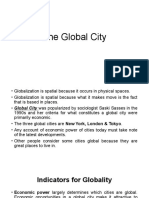Lesson 9 - Lecture Notes PDF
Uploaded by
Shiela maeLesson 9 - Lecture Notes PDF
Uploaded by
Shiela maeMODULE 2:
A World of Ideas:
Cultures of Globalization
This second unit focuses on how the globalization structures discusses in Module 1 affect various
forms of cultural life.
“Culture” is used here in the broadest possible sense, referring to the daily practices of people.
At the end of this Module, the student will be able to explain the role of global processes in everyday
life.
Lesson 9: The Global Cities
At the end of the lesson, students should be able to:
1. Explain why globalization is a spatial phenomenon;
2. Identify the attributes of a global city; and
3. Analyze how cities serve as engines of globalization
TERM BANK:
Global City
Spatial
Economic Power
Centers of Authority
Centers of Higher Learning and Culture
Study Guide Questions:
1. Why is globalization a spatial phenomenon?
2. What are global cities?
3. What are the indicators of globality?
4. What are the challenges of Global Cities?
Required Reading(s):
Chapter 8: The Global City
Pages 83 - 93
Abinales & Caludion (2018). The Contemporary World. Quezon City: C & E Publishing, Inc.
1|Page Prepared by: RHIZZA MAE ASOY
THE GLOBAL CITY
Why study global cities?
This lesson will emphasize that globalization is spatial.
1. Globalization is spatial because it occurs in physical spaces.
a. Most of the globalized activities or activities influenced heavily by
globalization such as foreign investments, capital movements, building
of skyscrapers, technological innovation, etc. occurs mostly in global
cities.
b. Albeit, the negative effects are thatmore and more people are driven
out of city centers to make for newdevelopments.
2. Globalization is spatial because what makes it move is the fact that it is based on
places.
a. Cities act on globalization and globalization acts on cities. In other words, cities
are sites as well as mediums of globalization.
Defining Global Cities:
• She popularized the term “global city”
• Her criteria of the globality of cities is primarily
ECONOMIC
• Using the criteria, Sassen identifies three global cities:
New York, London and Tokyo
• These three (3) cities are hubs of global finance and
capitalism and home of world’s top stock exchanges
where investors buy and sell shares in major
corporations.
Saskia Sassen
2|Page Prepared by: RHIZZA MAE ASOY
Indicators of Globality
1. Some Global Cities are Centers of Economic Power:
How to measure the economic competitiveness of a city, the Economist Intelligence Unit has added
other criteria such as:
1. Market Size
2. Purchasing Power of Citizens
3. Size of the Middle Class
4. Potential for Growth.
Example of Global Cities based on these criteria:
a. New York have the largest stock market in the world
b. Tokyo houses the greatest number of corporate headquarters
c. Shanghai has the world’s busiest container port, moving over 33 million units in 2013.
d. Singapore (a city-state) is considered Asia’s most competitive city because of its strong
market, efficient and incorruptible government, and livability.
2. Some Global Cities are Centers of Authority
a. Washington DC, may not be as wealthy as New York, but it is the seat of American state
power. People around the world know its major landmarks: the White House, the Lincoln
Memorial, and the Washington Monument.
b. Canberra is a sleepy town and thus not attractive to tourist but it is home to the country’s
top politicians, bureaucrats, and policy advisors.
3. The cities that house major international organizations may also be considered centers
of political influence.
a. The headquarters of United Nations is in New York, USA
b. The headquarters of European Union is in Brussels, Germany
c. The headquarters of ASEAN is in Jakarta, Indonesia.
Powerful political hubs exert influence on their own countries as well as on international affairs:
d. The European Central bank, which oversees the Euro (The European Union’s currency), is
based in Frankfurt.
4. Some Global Cities are Centers of Higher Learning and Culture.
a. A city’s intellectual influence is seen through the influence of its publishing industry.
3|Page Prepared by: RHIZZA MAE ASOY
i. Many of the books that people read are published in places like New York,
London, or Paris.
ii. Boston is highly visited because it is where Harvard University is located – the
world’s top university.
iii. Many Asian teenagers are moving to cities in Australia because of the leading
English-language universities there.
b. Cities are also world famous for something:
i. Los Angeles, USA is the center of the American film industry
ii. Copenhagen, Denmark is considered as the culinary capital of the world.
iii. Manchester, England holds the biggest bands in the world (such as Joy Division,
the Smiths, the Happy Mondays, making it a global household name.
iv. Seoul, South Korea, nowadays also holds global household names such as BTS,
Blackpink.
v. Singapore (again) houses Southeast Asia’s top television stations and news
organization
The Challenges of Global Cities:
Global Cities conjure up images of fast-paced, exciting, cosmopolitan lifestyles. But global cities
also have undersides. These are:
1. Global cities can be sites of great inequality and poverty as well as tremendous violence.
2. Most global cities have greatest per capita carbon footprint.
Cities can be sustainable because of their density. Moreover, in cities with extensive public
administration systems, people tend to drive less and thereby cut carbon emissions. As such, New
York (with extensive trains system), have the lowest per capita carbon foot print.
However, not all cities, are as dense as New York or Tokyo. Some cities like Lod Angeles are urban
sprawls, with massive freeways that force residents to spend money on cars and gas. And while
4|Page Prepared by: RHIZZA MAE ASOY
cities like Manila, Bangkok, and Mumbai are dense, their lack of public transportation and their
government’s inability to regulate their car industries have made them extremely polluted.
3. Because of the sheer size of city populations across the world, it is not surprising that urban areas
consume most of the world’s energy.
Cities consume 78% of global energy.
4. The major terror attacks of recent years have also targeted cities.
Cities, especially those with global
influence, are obvious targets for terrorist
due to their high populations and their role
as symbols of globalization that many
terrorists despise. For example, the 9/11
attack on the World Trade Organization in
2011 at New York.
The Global City and the Poor.
The massive inequality brought about by economic globalization is very pronounced in cities.
1. The Great Divide. In places like Mumbai (India), Jakarta (Indonesia), and Manila (Philippines), it
is common to find gleaming buildings alongside massive shantytowns.
2. Gentrification. It is the phenomenon of driving out the poor in favor of newer, wealthier
residents.
5|Page Prepared by: RHIZZA MAE ASOY
In the outskirts of New York and San Francisco are
poor urban enclaves occupied by African-Americans
and immigrant families who are often denied
opportunities at a better life. Slowly, they are being
forced to move farther away from the economic
centers of their cities. As a city attracts more capital
and richer residents, real estate prices go up and poor
residents are forced to relocate to far away but
cheaper areas.
3. In most of the world’s global cities, the middle class is also thinning out.
Conclusion:
• Global cities are sites and mediums of globalization. They are, therefore, material representations
of the phenomenon. Through them, we see the best of globalization; they are places that create
exciting fusions of culture and ideas. They are also places that generate tremendous wealth.
• Global cities remain sites of great inequality, where global servants serve global entrepreneurs.
6|Page Prepared by: RHIZZA MAE ASOY
You might also like
- City Buildings Silhouettes and Colors PowerPoint Templates WidescreenNo ratings yetCity Buildings Silhouettes and Colors PowerPoint Templates Widescreen16 pages
- GE3 - Contemporary World - The Global CityNo ratings yetGE3 - Contemporary World - The Global City3 pages
- Topic 5 - Global Population and MobilityNo ratings yetTopic 5 - Global Population and Mobility12 pages
- The Contemporary World Module 2 Lesson 3No ratings yetThe Contemporary World Module 2 Lesson 36 pages
- The Contemporary World - Global Population and MobilityNo ratings yetThe Contemporary World - Global Population and Mobility24 pages
- Week 9 Global Population and Mobility Global CityNo ratings yetWeek 9 Global Population and Mobility Global City43 pages
- cdn3.digialm.com__per_g28_pub_2083_touchstone_AssessmentQPHTMLMode1__2083O2581_2083O2581S6D41479_17438456258438065_TL02202981_2083O2581S6D41479E3.html#No ratings yetcdn3.digialm.com__per_g28_pub_2083_touchstone_AssessmentQPHTMLMode1__2083O2581_2083O2581S6D41479_17438456258438065_TL02202981_2083O2581S6D41479E3.html#37 pages
- Maize mid-density genotyping services _ ExcellenceinbreedingNo ratings yetMaize mid-density genotyping services _ Excellenceinbreeding4 pages
- prepare-for-ielts-general-training-volume-1_reading-practice-test-2-v9-5913720No ratings yetprepare-for-ielts-general-training-volume-1_reading-practice-test-2-v9-591372031 pages
- Effects of A Mycotoxins Binder On PlasmaNo ratings yetEffects of A Mycotoxins Binder On Plasma490 pages
- In Salah Gas Project Engineering Procurement & Construction PhaseNo ratings yetIn Salah Gas Project Engineering Procurement & Construction Phase17 pages
- Aggression and Violent Behavior Volume 4 Issue 2 1999 (Doi 10.1016/s1359-1789 (97) 00055-4) Mark Griffiths - Violent Video Games and Aggression - A Review of The LiteratureNo ratings yetAggression and Violent Behavior Volume 4 Issue 2 1999 (Doi 10.1016/s1359-1789 (97) 00055-4) Mark Griffiths - Violent Video Games and Aggression - A Review of The Literature10 pages
- Synthesis of Potassium Tris (Oxalato) Ferrate (III)84% (37)Synthesis of Potassium Tris (Oxalato) Ferrate (III)7 pages
- Instant Download (Ebook PDF) Child Development: A Thematic Approach 6th Edition PDF All Chapter100% (8)Instant Download (Ebook PDF) Child Development: A Thematic Approach 6th Edition PDF All Chapter41 pages
- International Journal of Solids and Structures: L. Wu, L. Noels, L. Adam, I. DoghriNo ratings yetInternational Journal of Solids and Structures: L. Wu, L. Noels, L. Adam, I. Doghri18 pages
- Myofascial Trigger Points: The Current Evidence: Leesa K. HugueninNo ratings yetMyofascial Trigger Points: The Current Evidence: Leesa K. Huguenin11 pages
- 11 We'Ll Bite Your Tail, Geronimo by Stilton, GeronimoNo ratings yet11 We'Ll Bite Your Tail, Geronimo by Stilton, Geronimo133 pages
- City Buildings Silhouettes and Colors PowerPoint Templates WidescreenCity Buildings Silhouettes and Colors PowerPoint Templates Widescreen
- The Contemporary World - Global Population and MobilityThe Contemporary World - Global Population and Mobility
- Holes In The Whole: Introduction to the Urban RevolutionsFrom EverandHoles In The Whole: Introduction to the Urban Revolutions
- cdn3.digialm.com__per_g28_pub_2083_touchstone_AssessmentQPHTMLMode1__2083O2581_2083O2581S6D41479_17438456258438065_TL02202981_2083O2581S6D41479E3.html#cdn3.digialm.com__per_g28_pub_2083_touchstone_AssessmentQPHTMLMode1__2083O2581_2083O2581S6D41479_17438456258438065_TL02202981_2083O2581S6D41479E3.html#
- Maize mid-density genotyping services _ ExcellenceinbreedingMaize mid-density genotyping services _ Excellenceinbreeding
- prepare-for-ielts-general-training-volume-1_reading-practice-test-2-v9-5913720prepare-for-ielts-general-training-volume-1_reading-practice-test-2-v9-5913720
- In Salah Gas Project Engineering Procurement & Construction PhaseIn Salah Gas Project Engineering Procurement & Construction Phase
- Aggression and Violent Behavior Volume 4 Issue 2 1999 (Doi 10.1016/s1359-1789 (97) 00055-4) Mark Griffiths - Violent Video Games and Aggression - A Review of The LiteratureAggression and Violent Behavior Volume 4 Issue 2 1999 (Doi 10.1016/s1359-1789 (97) 00055-4) Mark Griffiths - Violent Video Games and Aggression - A Review of The Literature
- Synthesis of Potassium Tris (Oxalato) Ferrate (III)Synthesis of Potassium Tris (Oxalato) Ferrate (III)
- Instant Download (Ebook PDF) Child Development: A Thematic Approach 6th Edition PDF All ChapterInstant Download (Ebook PDF) Child Development: A Thematic Approach 6th Edition PDF All Chapter
- International Journal of Solids and Structures: L. Wu, L. Noels, L. Adam, I. DoghriInternational Journal of Solids and Structures: L. Wu, L. Noels, L. Adam, I. Doghri
- Myofascial Trigger Points: The Current Evidence: Leesa K. HugueninMyofascial Trigger Points: The Current Evidence: Leesa K. Huguenin
- 11 We'Ll Bite Your Tail, Geronimo by Stilton, Geronimo11 We'Ll Bite Your Tail, Geronimo by Stilton, Geronimo





























































































